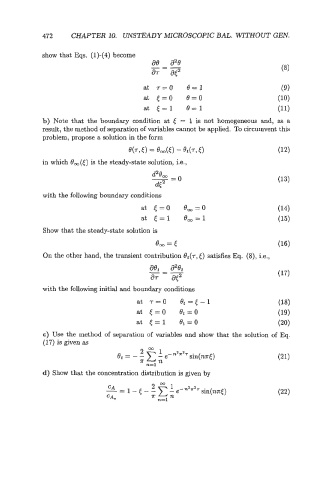Page 492 - Modelling in Transport Phenomena A Conceptual Approach
P. 492
472 CHAPTER 10. UNSTEADY MICROSCOPIC BAL. WITHOUT GEN.
show that Eqs. (1)-(4) become
ae
a2e
_- --
a~ at2
at T=O 8=1
at <=0 e=O
at t=1 8=1
b) Note that the boundary condition at = 1 is not homogeneous and, as a
result, the method of separation of variables cannot be applied. To circumvent this
problem, propose a solution in the form
e(T, 0 = ea40 - et(T, t) (12)
in which ea,(<) is the steady-state solution, i.e.,
with the following boundary conditions
at <=0 8,=0 (14)
at <=1 &=l (15)
Show that the steady-state solution is
e,=[
On the other hand, the transient contribution et(r,<) satisfies &. (8), Le.,
ae, a2e,
-- --
a7 at2 (17)
with the following initial and boundary conditions
at r=O Ot=<-l
at <=O &=O
at <=1 Ot=0
c) Use the method of separation of variables and show that the solution of Eq.
(17) is given as
2-1
et = - - - e-nzna7 sin(nnt) (21)
n
?r n=l
d) Show thslt the concentration distribution is given by

